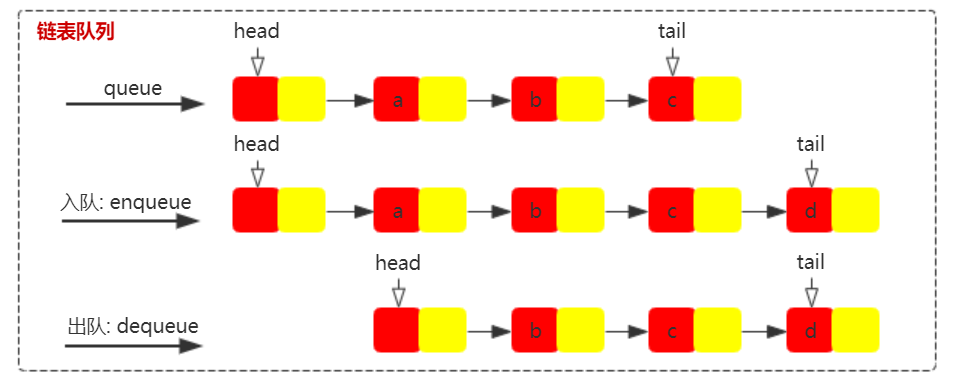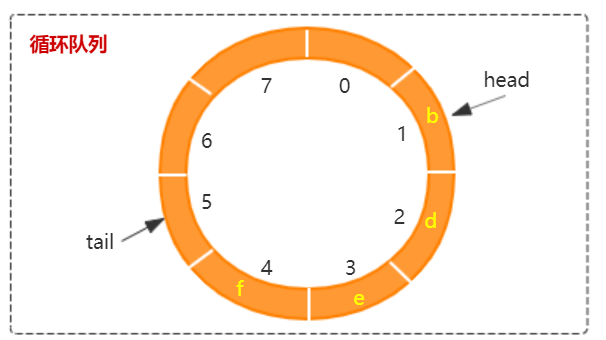Java 数据结构 - 队列
数据结构与算法目录(https://www.cnblogs.com/binarylei/p/10115867.html)
我们今天要讲的数据结构是队列,比如 Java 线程池任务就是队列实现的。
1. 什么是队列
和栈一样,队列也是一种操作受限的线性结构。使用队列时,在一端插入元素,而在另一端删除元素。

1.1 队列的主要特性
- 队列中的数据元素遵守 "先进先出"(First In First Out)的原则,简称 FIFO 结构。
- 限定只能在队列一端插入,而在另一端进行删除操作。
1.2 队列的相关概念
- 入队(enqueue):队列的插入操作。
- 出队(dequeue):队列的删除操作。
2. 复杂度分析
和栈一样,队列也有两种实现方案,我们简单分析一下这两种队列的复杂度:
- 动态队列(链表):也叫链式队列。其插入、删除时间复杂度都是 O(1)。
- 静态队列(数组):也叫顺序队列。当队列队尾指针移到最后时,此时有两种操作:一是进行简单的数据搬移,二是进行队列循环。
关于队列的实现,我们只实现如下的基本操作。
public interface Queue {
Queue enqueue(Object obj); // 入队
Object dequeue(); // 出队
int size(); // 元素个数
}
2.1 链式队列
链式队列的实现非常简单,其插入和删除的时间复杂度都是 O(1)。为了简化代码的实现,我们引入哨兵结点。如下图所示,head 头结点是哨兵结点,不保存任何数据,从 head.next 开始保存数据,tail 结点指向最后一个元素结点。链表队列头结点和尾结点说明:
- 头结点:head 结点为哨兵结点,不保存任何数据,数据从第二个结点开始。
- 尾结点:tail 结点指向最后一个数据结点。

根据上图,我们可以轻松实现一个链表组成的队列,代码也很简单。
public class LinkedQueue implements Queue {
private Node head;
private Node tail;
private int size;
public LinkedQueue() {
head = new Node(null, null);
tail = head;
}
@Override
public Queue enqueue(Object obj) {
tail.next = new Node(obj, null);
tail = tail.next;
size++;
return this;
}
@Override
public Object dequeue() {
Node next = head.next;
if (next == null) {
return null;
}
head = head.next;
size--;
return next.item;
}
@Override
public int size() {
return size;
}
public static class Node {
private Object item;
private Node next;
public Node(Object item, Node next) {
this.item = item;
this.next = next;
}
}
}
2.2 顺序队列
如果是数组实现的队列,则比链表要复杂一些,当尾结点指向数组的最后一个位置时,没有剩余的空间存放数据时,此时该如何处理?通过我们有两种解决方案:
- 数据搬移:将 head ~ tail 结点的数据搬移到从 0 结点开始。
- 循环队列:tail 结点从 0 开始循环使用,不用搬移数据。
我们先看一下循环队列

如上图所示,当尾结点指向数组最后一个位置,当 tail 指向数组最后位置时,触发数据搬移,将 head ~ tail 结点的数据搬移到从 0 结点开始。数组队列头结点和尾结点说明:
- 头结点:head 结点指向第一个数据结点。当 head == tail 时说明队列处于队空状态,直接返回 null。
- 尾结点:tail 结点指向最后一个数据之后的空结点。当 tail == capcity 时说明队列处于队满状态,需要扩容或进行数据搬移。
根据上述理论代码实现如下:
public class ArrayQueue implements Queue {
private Object[] array;
private int capcity;
// head指向第一个数据结点的位置,tail指向最后一个数据结点之后的位置
private int head;
private int tail;
public ArrayQueue() {
this.capcity = 1024;
this.array = new Object[this.capcity];
}
public ArrayQueue(int capcity) {
this.capcity = capcity;
this.array = new Object[capcity];
}
/**
* tail 指向数组最后位置时,需要触发扩容或数组搬移
* 1. head!=0 说明数组还有剩余的空间,将 head 搬运到队列 array[0]
* 2. head==0 说明数组没有剩余的空间,扩容
*/
@Override
public Queue enqueue(Object obj) {
if (tail == capcity) {
if (head == 0) {
resize();
} else {
rewind();
}
}
array[tail++] = obj;
return this;
}
@Override
public Object dequeue() {
if (head == tail) {
return null;
}
Object obj = array[head];
array[head] = null;
head++;
return obj;
}
// 将 head 搬运到队列 array[0]
private void rewind() {
for (int i = head; i < tail; i++) {
array[i - head] = array[i];
array[i] = null;
}
tail -= head;
head = 0;
}
// 扩容
private void resize() {
int oldCapcity = this.capcity;
int newCapcity = this.capcity * 2;
Object[] newArray = new Object[newCapcity];
for (int i = 0; i < oldCapcity; i++) {
newArray[i] = array[i];
}
this.capcity = newCapcity;
this.array = newArray;
}
@Override
public int size() {
return tail - head;
}
}
说明: 数组队列出队的时间复杂度始终是 O(1)。但入队时要分为三种情况:
- 有空间:大多数情况,也是最好时间复杂度 O(1)。
- 没有空间需要数据搬移:执行 n 后触发一次数据搬移,最坏时间复杂度 O(n)。
- 没有空间需要扩容:执行 n 后触发一次数据搬移,最坏时间复杂度 O(n)。
如果采用摊还分析法,最好时间复杂度 O(1),最坏时间复杂度 O(n),摊还时间复杂度为 O(1)。虽然,平均时间复杂度还是 O(1),但我们能不能不进行数据搬移,直接循环使用数组呢?
2.3 循环队列
循环队列是一种非常高效的队列,我们需要重点掌握它,要能轻松写出无 BUG 的循环队列。

数组队列头结点和尾结点说明:
- 头结点:head 结点指向第一个数据结点。当 head == tail 时说明队列处于队空状态,直接返回 null。否则在元素出队后,需要重新计算 head 值。
- 尾结点:tail 结点指向最后一个数据之后的空结点。每次插入元素后重新计算 tail 值,当 tail == head 时说明队列处于队满状态,需要扩容。
- 元素位置:对数组长度取模
(tail + 1) % length,所以这种数据为了提高效率,都要求数组长度为 2^n,通过位运算取模(tail + 1) & (length - 1)。
public class ArrayCircularQueue implements Queue {
private Object[] array;
private int capcity;
// 头结点指向
private int head;
private int tail;
public ArrayCircularQueue() {
this.capcity = 1024;
this.array = new Object[this.capcity];
}
public ArrayCircularQueue(int capcity) {
this.capcity = capcity;
this.array = new Object[capcity];
}
@Override
public Queue enqueue(Object obj) {
array[tail] = obj;
if ((tail = (tail + 1) % capcity) == head) {
resize();
}
return this;
}
@Override
public Object dequeue() {
if (head == tail) {
return null;
}
Object obj = array[head];
array[head] = null;
head = (head + 1) % capcity;
return obj;
}
// 不扩容,要先判断能否往数组中添加元素
public Queue enqueue2(Object obj) {
if ((tail + 1) % capcity == head) return this;
array[tail] = obj;
tail = (tail + 1) % capcity;
return this;
}
// 扩容
private void resize() {
// 说明还有空间
if (head != tail) {
return;
}
int oldCapcity = this.capcity;
int newCapcity = this.capcity * 2;
Object[] newArray = new Object[newCapcity];
for (int i = head; i < oldCapcity; i++) {
newArray[i - head] = array[i];
}
for (int i = 0; i < head; i++) {
newArray[capcity - head + i] = array[i];
}
this.capcity = newCapcity;
this.array = newArray;
this.head = 0;
this.tail = oldCapcity;
}
@Override
public int size() {
return tail - head;
}
}
说明: 循环队列关键是判断队空和空满的状态分别进行处理。除开扩容操作,循环队列的入队和出队的时间复杂度都是 O(1),同时也可以充分利用 CPU 缓存,所以说一种高效的数据结构。
2.4 阻塞队列和并发队列
3. 队列在软件工程中应用
如 JDK 线程池,当线程池没有空闲线程时,新的任务请求线程资源时,线程池该如何处理?各种处理策略又是如何实现的呢?我们一般有两种处理策略。
- 非阻塞的处理方式,直接拒绝任务请求;
- 阻塞的处理方式,将请求排队,等到有空闲线程时,取出排队的请求继续处理。
每天用心记录一点点。内容也许不重要,但习惯很重要!